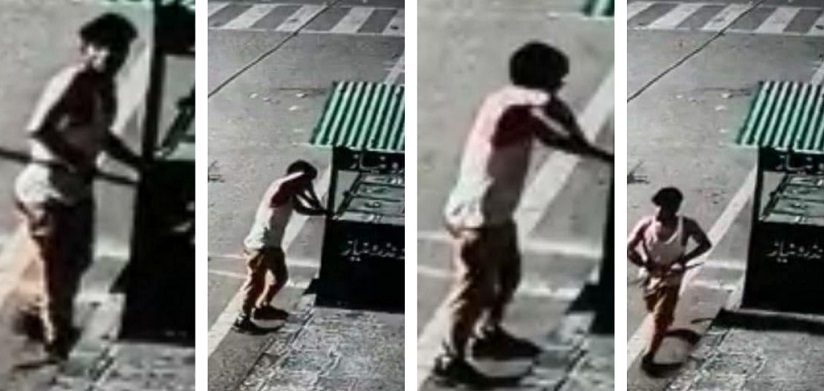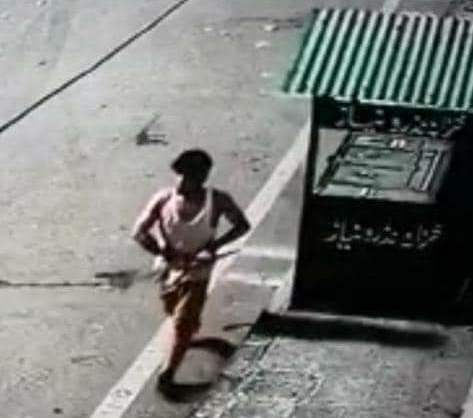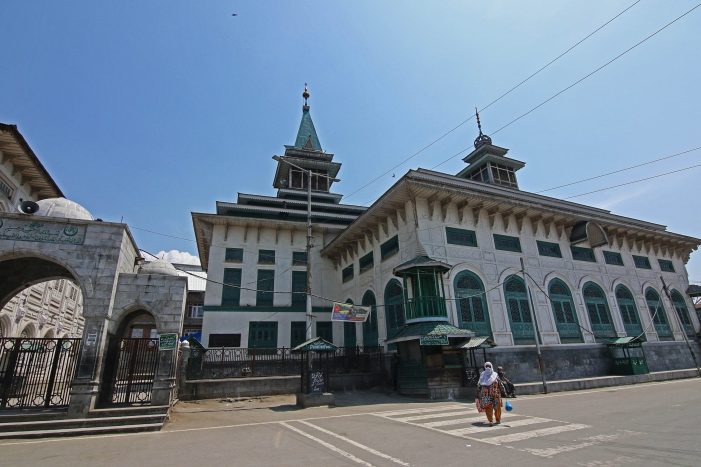
A series of shrine stealing incidents amid pandemic last year shocked the valley. While some of these dark crimes are still a matter of enquiry, Kashmir Observer follow-up unearthed a pattern wherein a dope-driven denizen surfaced as one of the main felons to steal from the ‘house of god’.
By Zeenish Imroz
IN the early fall of 2020, a half-naked man showed up in Srinagar’s Dastgeer Sahab shrine to commit yet another dark deed.
Amid pandemic, sanctums of Kashmir faced a wave of thefts. Such acts of stealing were first noticed by the early risers—muezzins—before a group of gumshoes would arrive at the crime scene for inspection.
At Khanyar, the boyish burglar’s midnight arrival looked like a classic case of burglary. His oily body reminded many of those hoary robbers of yore who would loot shelters and shops, and give slip to their captors with their greasy skin.
The bolstered thug, it seemed, was only following his tribe’s textbook rule.
With the dawn of 13 September 2020, the security guard of the shrine woke up for a routine inspection round. Leaving his wooden chamber through the entrance, he walked into the narrow corridor to the sanctum of Ghous-ul-Azam Dastgeer, Sheikh Abdul Qadir Jeelani [RA], where he was shocked to witness the security breach.
The donation box lied broken, empty of all the cash and gold.
The appalled guard immediately called Khalid Geelani, one of the members of the Intizamiya Committee of the shrine, to inform him about the robbery. Khalid, still asleep, woke up with a jerk. Shocked to hear about the theft, he decided to visit the shrine where he witnessed the chaotic scene of crime.
Khalid waited for other members to arrive for the pre-dawn prayer. On viewing the mind-numbing situation, the shrine custodians were in a dilemma — whether to offer prayers or not. After Khalid persuaded them to pray as there was no logic in visiting the police station so early, the prayer was held with disarrayed minds.
Inside the sanctum, Khalid along with some members of the Intizamiya Committee waited for the police station to become operational for filing the First Information Report (FIR).
Given the centrality of the shrine, the matter looked sensitive. But unlike last time, 2012, when the sanctum rose up in flames, cops faced no flaring tempers in “Naya Kashmir”. Heightened fortified footfall had created its own hush when the investigation team led by SDPO Farhan Jehanzaib, Inspector Parvaiz Ahmad Wani, ASI and head constable arrived and secured the crime scene.
After police’s special squad failed in sniffing some evidence, the Forensic Science Laboratory division was contacted for collecting fingerprints of the thief from the collection box. But the major breakthrough came from digital monitoring of the area. The police got evidence from their security cameras installed in the shrine that had captured the whole scene.
The CCTV footage showed a young man storming the shrine with an iron rod. He gathered his vest over his shoulders in an odd attempt to hide his identity. He held it between his teeth, hardly veiling any of his face. He peeked through the cavity into the donation box placed beneath the copper plate engraved with verses from the holy Quran and thousands of multi-coloured wish knots tied to its chains.
With a bizarre swiftness in his actions, he got his iron rod and tried penetrating it through the lock, applying full force but failed, persistently trying to break it. He held the box with a foot and subsequently tried to unlock it. After many failed attempts, he finally succeeded in the burglary of a shrine.
Though the footage was not clear, police identified the culprit — Tahir Ahmad Mir.

Tahir was born in a hamlet of Hardan, Kulgam in a family of traditional chefs. While his father Sanaulah Mir had moved to Srinagar for better earning 15 years ago, Tahir, according to police records, was in his hometown getting addicted to drugs and other crimes. “A teenager, he got addicted to heroin, charas, alcohol, and injectable drugs for which he needed money like many others who are gripped by the same addiction,” a cop part of the investigation said.
Tahir, the cop said, was high on drugs when he committed the midnight heist at Khanyar, which explains him entering with the shoes on into the sanctum and his failed attempt to cover his face.
“99 per cent of the criminals we deal with are drug addicts,” SHO Parvaiz of Khanyar Police Station told Kashmir Observer. “After emptying their houses, they start stealing for money outside to satisfy their dope cravings.”
The drug consumption has been on the rise since 2016. Shri Maharaja Hari Singh (SMHS) De-addiction Centre, the main such facility in the Kashmir Valley, has registered a 945 per cent rise in patients since 2016-17 — 489 patients visited its Out Patients Department (OPD) between April 2016 and March 2017, 3,622 in the next 12 months, and 5,113 in the 12 months after that.
Between April and June 2019, as many as 1,095 more patients visited the facility. According to data available with the main Srinagar hospital, it received 3,319 patients from July to November 2019.
For satiating the thirst for drugs, Tahir needed money in abundance. He began taking heroin which costs Rs. 1000 per gram amongst other drugs. After he started stealing from his own home, he moved out of the circle, attempting pity burglaries like bicycle theft, laptops and phones which led to many FIRs being registered against him.
Young and lean as he was, he would run too fast to be caught after a crime which resulted in a nickname being given to him. He was called “Namtah” after the Kashmiri idiom: “Namtan manz chol”, meaning “running fast like the wind”.
After occupying numerous FIRs with his name, Tahir had thought of giving his life a new direction in order to have a better future for him and his family. It eventually led him to leave his hometown of Kulgam and start a new life with his newly-wed wife in a shed near Srinagar outskirts, a place where his father had laid the foundation of his business fifteen years ago. However, in the lockdown city, Namtah stuck to his old guns.
After committing the crime, Tahir escaped for about 20 days and went to Jammu to dodge the police. When finally caught, he coughed up cash worth Rs 1,01,363 and some golden ornaments from his possession.
“During further questioning, one laptop, two cycles and nine mobile phones which have been stolen from different parts of Srinagar city were also recovered on his disclosure,” police said.

Interestingly, the suburb Tahir lived is notorious for its ‘highway heist’ history. “About 5 decades ago, the congested alleyways of this area served as a base to many robbery gangs who would rob travelers on Bandipora route, strip them naked and take their clothes as well,” said Ghulam Nabi Khayal, a Kashmiri seasoned scribe.
Even though these gangs were quite dreadful and looted the passerby in every possible way, their belief on the shrines wouldn’t allow them to be a part of any such sacrilege, Khayal continued.
“People were too faithful to commit a sin in the house of god,” the scribe said. “But today, youth is consumed by drugs, the pressure from family and unemployment being one of the reasons for pushing them to opt this method of pleasure. Ultimately, it’s forcing them to commit crimes like robbing a shrine.”
One such act in the tumultuous sixties had triggered a massive uprising in Kashmir.
On December 27, 1963, the holy relic of Prophet Muhammad [PBUH] was stolen from Hazratbal shrine which led to communal riots in the then East Pakistan (later Bangladesh) and West Bengal which left around 400 people dead.
Around 75,000 mourners carrying black flags gathered outside the shrine which coerced the government to impose an indefinite curfew around the valley. The theft of the holy relic immediately became global news enforcing sleepless nights and invoking immense pressure on the law-enforcement agencies and the Kashmir administration.
The then Prime Minister of the erstwhile state of Jammu and Kashmir, Khawaja Shams-ud-din had to leave the office due to the growing resentment among the local population for his administration’s failure in securing the relic. He was officially denounced from the Prime Minister’s post on February 29, 1964.
The relic was returned on 4 January 1964 by Abdul Rashid who was caught along with other two named by Gulzari Lal Nanda, the then Home Minister of India, one of whom was custodian of the shrine namely Abdul Rahim Banday, and the other was Qadir Bhat who was believed to have some affiliation with Pakistan.
That theft, in itself, had substantiated that Kashmir’s belief in shrines can never be broken and any kind of sacrilege would have vicious outcomes that could change the political and social atmosphere in the valley.
But in 2020 alone, the valley witnessed more than half a dozen thefts in the holy places. Though none of them harmed any sacrosanct, the burglary in shrines in itself is something that can invoke people hurting their religious sentiments.
The first case of theft was reported on June 20, 2020, at the shrine of Shams-ud-Din Iraqi located at Zadibal area of Srinagar, from where cash and goods were stolen followed by the theft at Dastgeer Sahab. Ten days after the Khanyar incident, Rehbab Sahib’s shrine was attacked as well.
These three shrines of Srinagar are located in the downtown area also known as Shehr-e-khaas which has been the hub of hue and cry against any movement that would hurt the religious sentiments.
Similar thefts were reported in Anantnag, Ganderbal and Baramulla districts where Ziyarat Malik Dawood shrine, Baba Haider Sahib shrine and Jamal Sahib shrine, and Nizamuddin Bukhari shrine were looted in 2020. All of them are under investigation.
Crime has reportedly increased in Kashmir since the abrogation lockdown coupled with the disastrous effects of coronavirus on the economy. According to the Kashmir Chamber of Commerce and Industry (KCCI), the erstwhile state suffered a loss of roughly $2.4 billion in the first four months of the political lockdown while the estimated industry losses for January 2020 to June 2020 amount to around $2.9 billion.
This reminds many of the 1929 Great Depression in the United States, when theft among other crimes began to increase, as unemployment and poverty peaked. Like that western recession phase, there’s a similar increase in unemployment in Kashmir – 20 per cent – further resulting in the frustration of the youth.
“Youth have been fired from their jobs and the burden of our financial needs is mentally putting us under too much strain to think straight and distinguish right from wrong,” said Javaid, a 30-year-old Kashmiri boy who was dismissed from his job in the Gulf and had to return to his homeland unemployed after 10 years of service.
“When you see your family starving, you can go to any extent to provide for them.”

These hardships and harsh realities of the land apart, the fact remains that what happened at Khanyar in the night of September 13, 2020 can be easily bracketed as a dope-driven act.
“That’s why we should’ve drug de-addiction centres in every Mohalla because most of the drug addicts become criminals because of the abundant need for money,” SHO Parvaiz Wani said.
Tahir needs treatment for drug de-addiction but remains detained in central jail, Srinagar for the crimes he has committed. At Dastgeer Sahab shrine, a 55-year-old shrine-regular, Habibullah prays for his transformation in the “house of correction”.
“When a thief stormed the saint’s home during his lifetime, he came out as Abdaal [a pious person],” Habibullah narrates a popular anecdote about the saint’s encounter with a stealer. “I hope the young man who looted the saint’s shrine comes out as a changed person one day.”
- Zaid Bin Shabir contributed reporting.
Follow this link to join our WhatsApp group: Join Now
Be Part of Quality Journalism |
Quality journalism takes a lot of time, money and hard work to produce and despite all the hardships we still do it. Our reporters and editors are working overtime in Kashmir and beyond to cover what you care about, break big stories, and expose injustices that can change lives. Today more people are reading Kashmir Observer than ever, but only a handful are paying while advertising revenues are falling fast. |
| ACT NOW |
| MONTHLY | Rs 100 | |
| YEARLY | Rs 1000 | |
| LIFETIME | Rs 10000 | |










